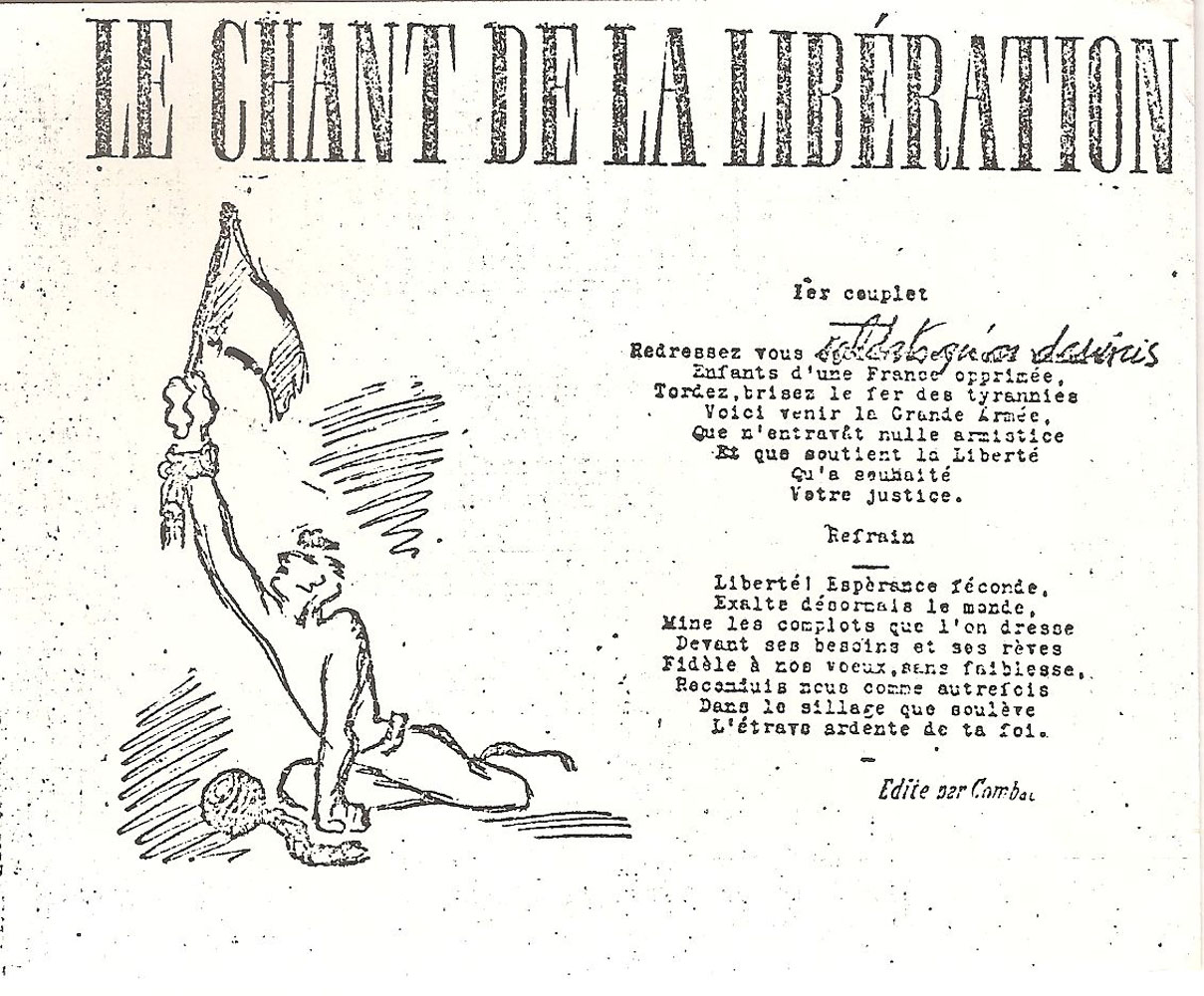Chant de la Libération diffusé pour le 14 juillet 1943
Légende :
Chant de la Libération diffusé par le mouvement Combat pour le 14 juillet 1943
"Song of the Liberation" circulated by the Combat movement for July 14th, 1943
Genre : Image
Type : Document
Source : © Collection MRA Droits réservés
Détails techniques :
Format 11 x 14, recto-verso.
Date document : 14 juillet 1943
Lieu : France - Provence-Alpes-Côte-d'Azur - Alpes-Maritimes - Nice
Analyse média
Ce "Chant de la Libération" fut rédigé par Fernand Alizard, mis en musique par Joseph Kosma, replié sur la Côte d'Azur, le dessin étant l'oeuvre de Georges Renevey et le tout ayant été photogravé par Robert Thivin, employé de L'Eclaireur de Nice. Il fut diffusé à une dizaine de milliers d'exemplaires à l'occasion de ce que les résistants de Combat pensaient être le dernier 14 juillet d'Occupation. Le dessin est intéressant puisqu'il montre un résistant brandissant un drapeau tricolore frappé de la Croix de Lorraine, la chaîne attachée à sa jambe droite étant brisée, symbole d'affranchissement de l'esclavage. Ce dessin est l'un des deux logos du Musée de la Résistance azuréenne (Nice) depuis 2004.
The "Song of the Liberation” was written by Fernand Alizard, set to music by Joseph Kosma, whom had taken refuge in the Côte d'Azur with the illustration done by the work of Georges Renevey and photography by Robert Thivin, an employee of the newspaper L’Éclaireur de Nice ("The Scout of Nice"). Tens of thousands of copies were made for the Combat movement which assumed was the last July 14th under occupation. The illustration is noteworthy as it portrays a Resistance fighter carrying a French flag with the cross of Lorraine. Attached to his right leg is a chain that has been broken, a symbol of freedom from slavery. This illustration is now one of the two logos for the Museum of the Résistance in the Côte d'Azur in Nice since 2004.
Jean-Louis Panicacci, La Résistance azuréenne, Nice, Serre, 1994.
Traduction : Sarah Buckowski.
Contexte historique
Le mouvement Combat fut particulièrement actif pour la préparation du 14 juillet 1943, diffusant simultanément ce "Chant de la Libération", des milliers de faux timbres Pétain portant l'effigie du général de Gaulle et le N° 1 du journal La France. Fernand Alizard quittera Combat en juin 1944 pour rejoindre le Front national de lutte pour l'indépendance de la France, devenant directeur du quotidien Le Patriote niçois après la Libération. Joseph Kosma, interdit d'exercer officiellement son métier aux Studios de la Victorine en raison du statut des Juifs, rejoindra le maquis de Combat au-dessus de Vence et sera blessé en juin 1944. Georges Renevey deviendra le chef régional-adjoint du mouvement Combat - MNRPGD en avril 1944, puis conseiller municipal de Nice en avril 1945. Quant au photograveur Robert Thivin, arrêté par la Gestapo, il sera étranglé dans sa cellule de l'Hermitage le 3 février 1944 ; une rue de Nice porte son nom depuis 1946.
The Combat movement of the Interior Résistance was particularly active in the preparation for independence day, July 14th, 1943, circulating simultaneously "Song of the Liberation" as well as thousands of stickers with the effigy of General de Gaulle and the first issue of the newspaper "La France". Fernand Alizard left the Combat movement in June 1944 to join the National Front for the Independence of France, and would become the editor-in-chief of daily newspaper Le Patriote niçois after the Liberation. Joseph Kosma was not able to continue working in the cinema Studios de la Victorine because of the antisemitic laws, and would join the Combat maquis above Vence, later, before being hurt in June 1944. Georges Renevey would become the regional joint leader of Combat-MNRPGD in April 1944, and later a city councillor of the City of Nice in April 1945. As to photoengraver Robert Thivin, he was arrested by the Gestapo, and later strangled in his prison cell of l'Hermitage, on February 3rd, 1944 ; ever since 1946, a street of Nice was named after him.
Jean-Louis Panicacci, Les Alpes-Maritimes dans la guerre, 1939-1945, Paris et Riom, De Borée, 2013.
Jean-Louis Panicacci, Les lieux de mémoire de la Deuxième Guerre mondiale dans les Alpes-Maritimes, Nice, Serre, 1997.
Traduction : Sarah Buckowski.



 Voir le bloc-notes
()
Voir le bloc-notes
()